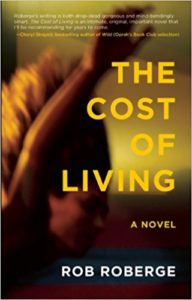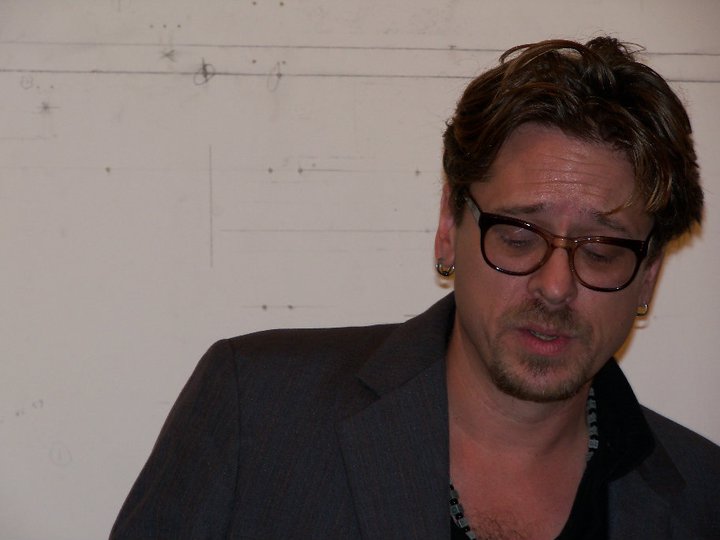Every month, I interview an author I admire on his literary firsts.
 April’s featured author is Rob Roberge, author of The Cost of Living, a wild ride of a novel starring Bud Barrett — guitarist of an indie rock band — who goes from reckless days of touring and partying with strangers and hiding his drug addiction to getting sober and confronting the traumas and mistakes of the past.
April’s featured author is Rob Roberge, author of The Cost of Living, a wild ride of a novel starring Bud Barrett — guitarist of an indie rock band — who goes from reckless days of touring and partying with strangers and hiding his drug addiction to getting sober and confronting the traumas and mistakes of the past.
Rob’s most recent book is Liar, a memoir with many similarities to The Cost of Living. He’s also authored three other works of fiction: Working Backwards from the Worst Moment of My Life, More Than They Could Chew, and Drive.
In this interview, Rob talks about the vital role played by indie publishers in the literary marketplace, binge writing, and the difference between memoir and fiction drawn from life.
Sign up with your email below to be entered to win a copy of The Cost of Living — and to get notified of future interviews!
____
 Siel: We have one thing in common as writers: We both have books with Red Hen Press! Yours, a short story collection called Working Backwards From the Worst Moment of My Life, came out in 2010. So this question is a personal one: What is the one piece of advice you’d have for a writer who’s just published a book with an indie press?
Siel: We have one thing in common as writers: We both have books with Red Hen Press! Yours, a short story collection called Working Backwards From the Worst Moment of My Life, came out in 2010. So this question is a personal one: What is the one piece of advice you’d have for a writer who’s just published a book with an indie press?
Rob: I’d say that there’s no one in the indie press world who isn’t in it unless they love books and love keeping the community of literature going. No one goes into indie publishing hoping to make a living at it. So, trust that—despite the fact that the press (any of them) may have limited resources for promotion and the like—they care deeply about you and their book. Some books gain traction in the marketplace…some don’t…but know that the press wants all of them to…for their sake and the writer’s sake.
So, I guess my biggest piece of advice would be to be realistic about the reach a book may be able to have. It’s not a question of quality. Indie presses are putting out some of the best books out there these days. With the death of the mid list on the trades, it’s come to indies to pick up those books by respected career writers who haven’t hit big in the profit-driven business model of the trade publishers. And on the new untested but great writers. This is an important gift for writers. And readers. That books that matter have a home and are still out there and available.
Your first book, Drive, came out in 2001. How has your writing routine changed, if at all, in the years between then and now?
I had more time then. Or maybe more energy. I was younger. I could do a lot of things at once more than I seem to be able to now. My health was better. But those are all minor things in the big picture. I still seem to get work done. I finished a book in two years that came out in 2013 (The Cost of Living), and then finished another in under two years that came out in early 2016 (Liar), so I guess I still get my work done.
The routine hasn’t changed too much. I’m a binge writer, not an everyday writer. I go long periods (especially when I’m teaching a lot) without writing books. Then, when I’m deep into a project, eight to ten hour days are normal…5000 to 10,000 word days aren’t NORMAL, but they happen. Sometimes I have written for anywhere from 24-72 hours (though I’m not supposed to with my having bipolar disorder…it’s not so wise…so I don’t do it much anymore. It sets off bad patterns).
I’ve always sort of wanted to be an everyday writer. But it just doesn’t seem to be the way I work.
At your launch reading for your latest book, Liar, you mentioned that your work has gotten more and more autobiographical. Why do you think that is? Is it a simple function of age — or something else?
I’m not sure. But I think (well, I know) it’s over. As each novel got progressively more autobiographical, that led to doing the memoir where I figured I’d just cop to the fact that a lot of my writing was about me by…well, writing overtly about me. But that seemed to be the end of a period in my writing. A phase that’s over. No more first person. No more basing protagonists on me (at least for the foreseeable future). My new book that I’m working on covers fifty years and 6 points of view…all lives very different from mine. It seemed time to move on.
On that note — The fictional protagonist in The Cost of Living has quite a lot in common with your characterization of yourself in your memoir, Liar. In fact, some plot points even repeat in the two books! As you were writing these books, were you picturing more or less the same “character”? Or were the two “protagonists” of these works very separate and different in your mind?
I pictured them as separate…even though they covered a lot of the same ground. They both are musicians, recovering addicts, have pretty severe bipolar. So, there’s a lot. But, for one thing, the structure was radically different. And I’m a big believer in form not just influencing content, but on some levels being content. The Cost of Living wasn’t a novel that challenged the form of the novel in any way (which was fine). But in Liar, I was trying to do things structurally that I hadn’t seen other memoirs do. Whether it was successful for not is for other people to decide. But that was a goal. And it made them pretty different projects, even though they shared a lot of details.
Which of your books was the most difficult to write?
Liar, by far. For both the reasons above and for personal reasons. It was the most challenging from a craft standpoint. And it was the one where I had to be most naked and vulnerable with the reader. Hardest by far. Maybe not the hardest to write (they’re all hard), but by far the hardest to release.
___
Purchase a copy of The Cost of Living now, or enter to win one by signing up for the newsletter. Already joined up? Then you’re already entered!

